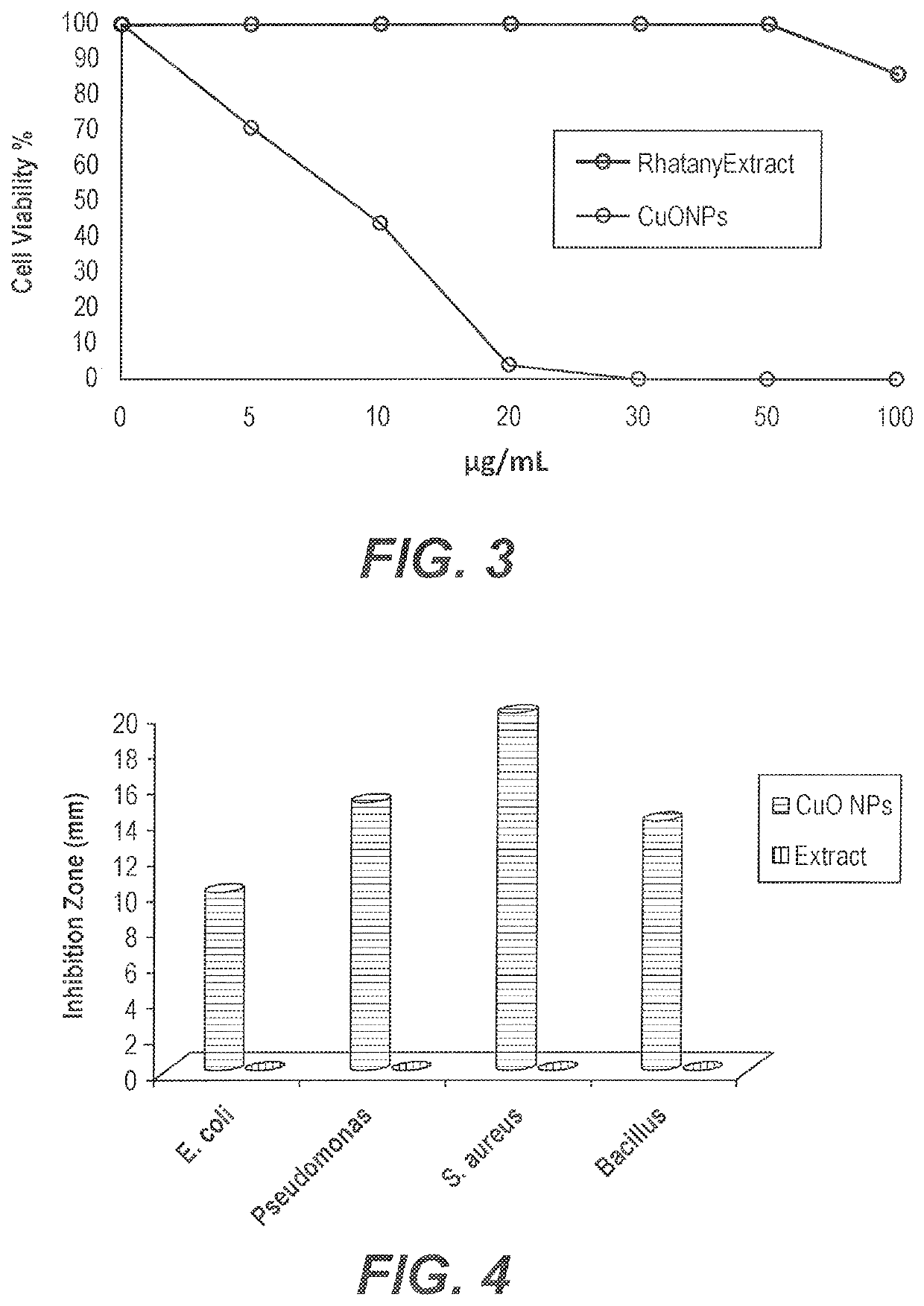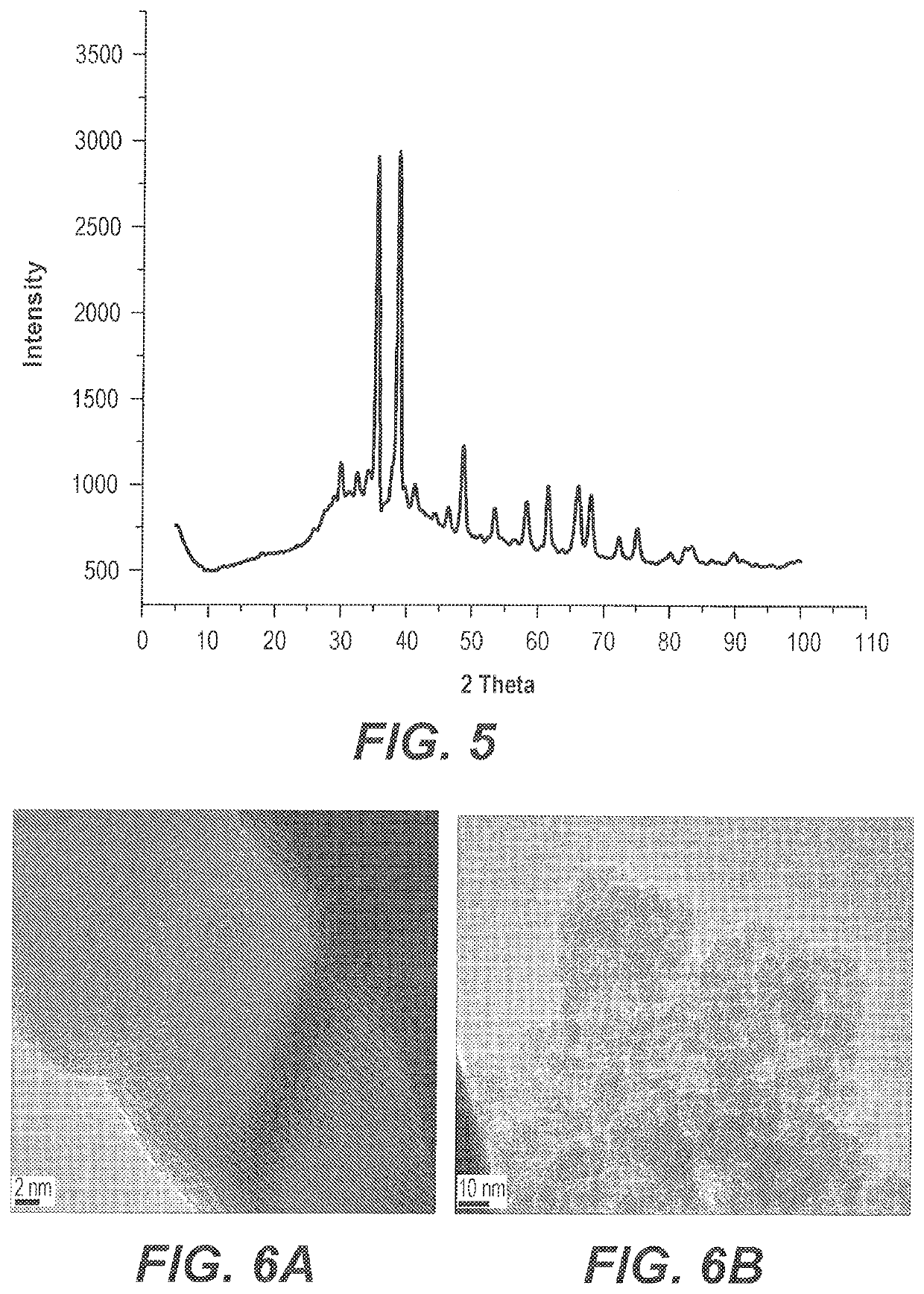Copper oxide nanoparticles synthesized using rhatany root extract
a technology of copper oxide nanoparticles and rhatany root extract, which is applied in the direction of physical/chemical process catalysts, metal/metal-oxide/metal-hydroxide catalysts, drug compositions, etc., can solve the problems of toxic chemicals used in conventional techniques for preparing copper oxide nanoparticles, uneconomical, and complicated methodologies, etc., to achieve antibacterial activity and anticancer
- Summary
- Abstract
- Description
- Claims
- Application Information
AI Technical Summary
Benefits of technology
Problems solved by technology
Method used
Image
Examples
example 1
Rhatany Root Extraction
[0019]Rhatany triandra roots were collected from a spice dealer at the local market in Riyadh, Saudi Arabia, and then were washed several times with tap water, and finally with deionized water. Then, the roots were dried and powdered. To prepared the extract; 10 g of Rhatany root powder was added to 100 mL of boiling deionized water and soaked overnight. Then, the aqueous extract was filtered using Whatman filter paper.
example 2
Synthesis of Copper Oxide Nanoparticles
[0020]Approximately 100 ml of copper sulfate (0.1 M) solution was prepared and equal volume of aqueous Rhatany roots extract (100 ml) was added, and then the mixed solution was heated in a heating mantle at 80° C. for 40 min, resulting in a red-colored mixture. Drop-wise addition of 1 M NaOH changes the “green” mixture to a brown precipitate, indicating the formation of nanoparticles of water soluble copper oxide. After the color change, the synthesized CuONPs were purified for 20 minutes by centrifugation at 8000 rpm, and then washed with ethanol solvent to remove excess plant compounds and other impurities. After drying at 60° C., the brown powder was then calcined at 400° C. for 4 hours.
example 3
Copper Oxide Nanoparticles as Catalyst for Photodegradation of Dyes
[0021]The photocatalytic property of the synthesized CuONPs was revealed by the potential for degradation of pollutant dyes.
[0022]Photocatalytic degradation activity of the synthesized CuO nanoparticles was estimated by the disintegration of crystal violet (CV) and methylene blue (MB) dyes under UV lamp irradiation. For this study, 1 mg L−1 of the synthesized CuO nanoparticles was added to 30 mL of CV and MB dye solutions. The photocatalyst samples were dispersed inside the beaker facing UV light at a distance from the lamp (lamp of UV light) under action of a stirrer. Optical absorption spectra were determined upon different light exposure durations using a UV / Vis spectrophotometer in order to monitor the rate of degradation by recording the reduction in absorption intensity of the respective dye at the maximum wavelength. The degradation efficiency (DE) was calculated as in the equation:
DE %=(A0−A) / A0×100
where A0 i...
PUM
| Property | Measurement | Unit |
|---|---|---|
| diameter | aaaaa | aaaaa |
| diameter | aaaaa | aaaaa |
| volume | aaaaa | aaaaa |
Abstract
Description
Claims
Application Information
 Login to View More
Login to View More - R&D
- Intellectual Property
- Life Sciences
- Materials
- Tech Scout
- Unparalleled Data Quality
- Higher Quality Content
- 60% Fewer Hallucinations
Browse by: Latest US Patents, China's latest patents, Technical Efficacy Thesaurus, Application Domain, Technology Topic, Popular Technical Reports.
© 2025 PatSnap. All rights reserved.Legal|Privacy policy|Modern Slavery Act Transparency Statement|Sitemap|About US| Contact US: help@patsnap.com



